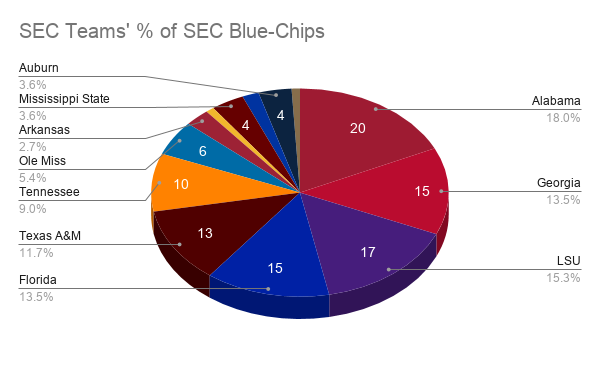We’ve talked a lot about blue-chip recruiting ratio around here. The idea is that if a team wants to have legitimate national championship hopes, its recruiting class has to consist of at least 50% 5- and 4-star recruits.
That’s true, but it’s also true that football is a game of relativity, and as much as it matters that you hit certain standards, it matters more how you compare to your competition. As Will recently pointed out, a blue-chip ratio of 50% is probably not a high enough target for the Vols due to their schedule regularly featuring teams with even higher blue-chip ratios. When Alabama and Georgia are regularly hovering around 80%, the milestone of hitting 50% doesn’t matter nearly as much as it otherwise would.
The whole concept of “gap” in college football has been on my mind a lot lately. Everybody loves lists, and we have a tendency to look at them and draw conclusions based solely on rankings while completely ignoring the ratings that lead to those rankings. In doing so, we miss the gap. Being in second place doesn’t mean you’re in contention for first if you’re miles behind.
National Signing Day Part I on Wednesday got me thinking about recruiting gaps, and that led me to wonder just how much food was on the table and how much was being hoarded by the heavies in this league.
Using 247Sports’ data (including both signees and commits and current as of the morning of 12.17.20), there are 111 blue-chip recruits and 167 others. Over 81% of the blue-chips went to only six teams, less than half of the league.
That’s a huge disparity between the top six teams and the rest of the conference, but the disparity is also quite pronounced among those six. For instance, the sixth team on the list had only half as many blue-chips as the first. Alabama, whose kingdom extends from the castle campus to the recruiting trails, has a full 18% of all of the SEC blue-chip recruits.
Here’s a visual:
And here is the same information in another form:
One of Tennessee’s main challenges, of course, is not only that it is the sixth team on the list. And it’s not only that plus the fact that most of those other five teams have at least 50% more blue-chips than do the Vols. It’s both of those things, plus the fact that they have to play three (and sometimes four) of those teams every season. They could do well and never know it because so many of their regular opponents are doing even better.
All of that leads to a question about on-field strategy. If the coaching staff is committed to coaching techniques and game plans that rest on an assumption that you have more talent than your opponent, they’re essentially conceding at least three losses every year, at least until they can catch some of those other teams on the recruiting trail. The rub is that it’s hard to catch those other teams when they are also winning more often and turning coaches over less often than you are. And if you not only lose to more-talented teams but to less-talented ones as well, you have a real problem. You need wins to improve your blue-chip ratio, and you need a better blue-chip ratio to get more wins.
There’s both a chicken and egg shortage on Rocky Top. Tennessee doesn’t need both an elite blue-chip ratio and all the wins our hearts desire right now, but it does need to figure out how to bootstrap itself into one or the other quickly. Being sixth on a short list of luminaries is not an insignificant accomplishment, but in this case, it hides just how long the journey is to the desired destination.
What’s the solution? That, of course, is the million dollar question and will have to wait for another day and another post.
